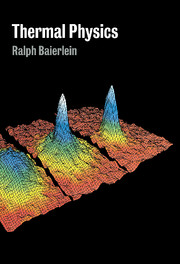Book contents
- Frontmatter
- Contents
- Preface
- 1 Background
- 2 The Second Law of Thermodynamics
- 3 Entropy and Efficiency
- 4 Entropy in Quantum Theory
- 5 The Canonical Probability Distribution
- 6 Photons and Phonons
- 7 The Chemical Potential
- 8 The Quantum Ideal Gas
- 9 Fermions and Bosons at Low Temperature
- 10 The Free Energies
- 11 Chemical Equilibrium
- 12 Phase Equilibrium
- 13 The Classical Limit
- 14 Approaching Zero
- 15 Transport Processes
- 16 Critical Phenomena
- Epilogue
- Appendix A Physical and Mathematical Data
- Appendix B Examples of Estimating Occupation Numbers
- Appendix C The Framework of Probability Theory
- Appendix D Qualitative Perspectives on the van der Waals Equation
- Index
4 - Entropy in Quantum Theory
Published online by Cambridge University Press: 05 June 2012
- Frontmatter
- Contents
- Preface
- 1 Background
- 2 The Second Law of Thermodynamics
- 3 Entropy and Efficiency
- 4 Entropy in Quantum Theory
- 5 The Canonical Probability Distribution
- 6 Photons and Phonons
- 7 The Chemical Potential
- 8 The Quantum Ideal Gas
- 9 Fermions and Bosons at Low Temperature
- 10 The Free Energies
- 11 Chemical Equilibrium
- 12 Phase Equilibrium
- 13 The Classical Limit
- 14 Approaching Zero
- 15 Transport Processes
- 16 Critical Phenomena
- Epilogue
- Appendix A Physical and Mathematical Data
- Appendix B Examples of Estimating Occupation Numbers
- Appendix C The Framework of Probability Theory
- Appendix D Qualitative Perspectives on the van der Waals Equation
- Index
Summary
This chapter has two goals. The first is to develop the quantum version of multiplicity. That will show us how entropy is expressed in quantum theory. The second goal is to develop a general quantitative definition of temperature. Entropy plays a key role in that definition.
The density of states
When a physical system has reached thermal equilibrium, its macroscopic properties do not change with time. In quantum theory, the energy eigenstates of an isolated system provide predictions and estimates that are constant in time; therefore such states are appropriate for a quantum description of thermal equilibrium.
To be sure, the information at hand will not enable us to select a single state as uniquely the correct state to use. We will be driven to consider many states and to form sums over them. This section develops a mathematical technique for working with such sums.
When the system is both isolated and of finite size (as we shall specify here), the energy eigenstates form a discrete set, whose members we can arrange and label in order of increasing energy. (If any two distinct states happen to have the same energy, we just assign them consecutive labels.) Typically, the states will be densely spaced in energy, and so a sum over a range of states can often be approximated adequately by an integral with respect to energy, provided that we have constructed an appropriate density of states: a function that specifies the number of energy eigenstates per unit energy interval.
Information
- Type
- Chapter
- Information
- Thermal Physics , pp. 75 - 88Publisher: Cambridge University PressPrint publication year: 1999
